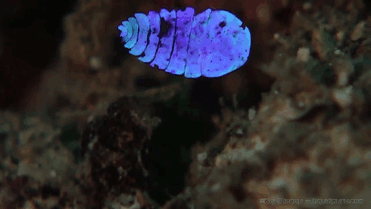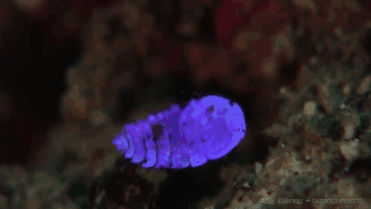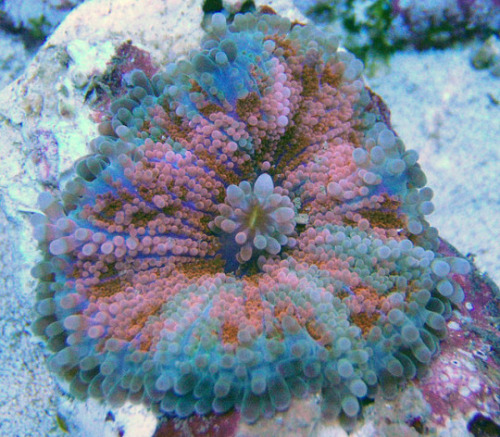This Is A Sea Sapphire! And When It Doesn’t Look Amazing It’s Invisible!


This is a Sea Sapphire! And when it doesn’t look amazing it’s invisible!
This is a type of crustacean called a copepod. It’s back is covered in guanine crystals. If it weren’t for these crystals the Sea Sapphire would be transparent, but these crystals are spaced in such a way that they strongly reflect certain colours of light. The colour of the light that’s reflected is dependent on the angle that it comes in.
Usually, it reflects blue light, but when the light hits the Sea Sapphire at 45 degrees, the reflected light shifts into the ultraviolet. And since we can’t see that it becomes invisible!
More Posts from The-sleepy-chemist and Others
“i should drink more water” i remind myself, halfway through my fifth coffee


Flower Mushroom Coral - Ricordea yuma
Ricordea yuma (Corallimorpharia - Ricordeidae) is a species of soft coral belonging to a group commonly referred to as mushroom corals. These soft corals are very popular among aquarists due to their vibrant and varied color patterns.
Ricordea yuma is found in the tropical Pacific. Like other Corallimopharians, this one has the ability to rapidly colonize available substrate.
References: [1] - [2] - [3]
Photo credits: [Top: ©Felix Salazar | Locality: nano reef tank, 2008] - [Bottom: ©Scott Cohen | Locality: reef tank, 2009]

KISS OF DEATH
One of the reasons cancer is so hard to defeat is that the body’s immune system has trouble recognizing cancer cells growing among healthy cells. Some scientists want to help. Researchers designed mouse T cells to specifically bind to a protein complex on fibrosarcoma MC57 tumor cell membranes. In this sped-up video, once the T cells (each about 10 μm across) meet their targets, they create holes in the cancer cell membranes using a protein called perforin. Next, the immune cells flood the pierced cells with a rush of cell-killing granules called granzymes. Propidium iodide, a dye the scientists added to the plate of cells, also squeezes in through the hole and starts glowing red when it comes in contact with RNA and DNA inside the cancer cells. This tells the researchers that the cells have been pierced and will soon die. This process takes about 75 minutes in real time.
Credit: Misty Jenkins (Read the paper.)
Related C&EN content:
The Immune System Fights Back
Cancer-Killing Machine
I Recently read About these amazing glow in the dark creatures in the newspapers and thought it was worth sharing 1. Saprobe Panellus Stipticus, Fungi:


Found in Asia, Australia, Europe and North America, the bio-luminescence emitted by the Saprobe fungi that grows on decaying wood...
Mammals both produce milk and have hair. Ergo, a coconut is a mammal.

This week is Antibiotic Awareness Week – learn more about the different types of antibiotics with this graphic!
maybe if im under enough blankets, the Responsibilities wont be able to find me

Aurora - Nutirwik Creek, Brooks Range, Alaska | by Fred Wasmer

Nothing can stop us!

Viscosity can have a notable effect on droplet impacts. This poster demonstrates with snapshots from three droplet impacts. The blue drops are dyed water, and the red ones are a more viscous water-glycerol mixture. When the two water droplets impact, a skirt forms between them, then spreads outward into a sheet with a thicker, uneven rim before retracting. The second row shows a water droplet impacting a water-glycerol droplet. The less viscous water droplet deforms faster, wrapping around and mixing into the other drop before rebounding in a jet. The last row switches the impacts, with the more viscous drop falling onto the water. As in the previous case, the water deforms faster than the water-glycerol. The two mix during spreading and rebound slower. In the last timestep shown, the droplet is still contracting, but it does rebound as a jet thereafter. (Image credit: T. Fanning et al.)
-
 yoda2691-iii liked this · 7 months ago
yoda2691-iii liked this · 7 months ago -
 ironruinsstrawberry liked this · 9 months ago
ironruinsstrawberry liked this · 9 months ago -
 aultreneveulxestre liked this · 1 year ago
aultreneveulxestre liked this · 1 year ago -
 arcane-aenigma liked this · 1 year ago
arcane-aenigma liked this · 1 year ago -
 mercurialesbica liked this · 1 year ago
mercurialesbica liked this · 1 year ago -
 sevvventhson reblogged this · 1 year ago
sevvventhson reblogged this · 1 year ago -
 stormsssandsaints reblogged this · 1 year ago
stormsssandsaints reblogged this · 1 year ago -
 110car8s liked this · 1 year ago
110car8s liked this · 1 year ago -
 jlmahmud liked this · 1 year ago
jlmahmud liked this · 1 year ago -
 praline1968 liked this · 1 year ago
praline1968 liked this · 1 year ago -
 summerwages liked this · 1 year ago
summerwages liked this · 1 year ago -
 prettyclover reblogged this · 1 year ago
prettyclover reblogged this · 1 year ago -
 stanfave3-72217 reblogged this · 1 year ago
stanfave3-72217 reblogged this · 1 year ago -
 ssolson liked this · 1 year ago
ssolson liked this · 1 year ago -
 mysticofthepinknight liked this · 1 year ago
mysticofthepinknight liked this · 1 year ago -
 divine-consciousness23 liked this · 1 year ago
divine-consciousness23 liked this · 1 year ago -
 blackforestnymph reblogged this · 1 year ago
blackforestnymph reblogged this · 1 year ago -
 margocooper liked this · 1 year ago
margocooper liked this · 1 year ago -
 dreamoftheotherlife reblogged this · 1 year ago
dreamoftheotherlife reblogged this · 1 year ago -
 dreamoftheotherlife liked this · 1 year ago
dreamoftheotherlife liked this · 1 year ago -
 spayki liked this · 1 year ago
spayki liked this · 1 year ago -
 traumatizedvodka liked this · 1 year ago
traumatizedvodka liked this · 1 year ago -
 sharkodaktyl reblogged this · 1 year ago
sharkodaktyl reblogged this · 1 year ago -
 sharkodaktyl liked this · 1 year ago
sharkodaktyl liked this · 1 year ago -
 brapclinic liked this · 1 year ago
brapclinic liked this · 1 year ago -
 slavering-ghoul reblogged this · 1 year ago
slavering-ghoul reblogged this · 1 year ago -
 slavering-ghoul liked this · 1 year ago
slavering-ghoul liked this · 1 year ago -
 mchai reblogged this · 1 year ago
mchai reblogged this · 1 year ago -
 vuonkhuya liked this · 1 year ago
vuonkhuya liked this · 1 year ago -
 welufo reblogged this · 1 year ago
welufo reblogged this · 1 year ago -
 welufo liked this · 1 year ago
welufo liked this · 1 year ago -
 kyriamou liked this · 1 year ago
kyriamou liked this · 1 year ago -
 wayti-blog reblogged this · 1 year ago
wayti-blog reblogged this · 1 year ago -
 wayti-blog liked this · 1 year ago
wayti-blog liked this · 1 year ago -
 andreacantillos reblogged this · 1 year ago
andreacantillos reblogged this · 1 year ago -
 wildernestt reblogged this · 2 years ago
wildernestt reblogged this · 2 years ago -
 timeofdeathsworld liked this · 2 years ago
timeofdeathsworld liked this · 2 years ago -
 tanto-seppuku liked this · 2 years ago
tanto-seppuku liked this · 2 years ago -
 julcol reblogged this · 2 years ago
julcol reblogged this · 2 years ago -
 missladypugg reblogged this · 2 years ago
missladypugg reblogged this · 2 years ago -
 missladypugg liked this · 2 years ago
missladypugg liked this · 2 years ago -
 astronomicalblaze reblogged this · 2 years ago
astronomicalblaze reblogged this · 2 years ago -
 teiatm reblogged this · 2 years ago
teiatm reblogged this · 2 years ago -
 teiatm liked this · 2 years ago
teiatm liked this · 2 years ago -
 lissette reblogged this · 2 years ago
lissette reblogged this · 2 years ago
60 posts